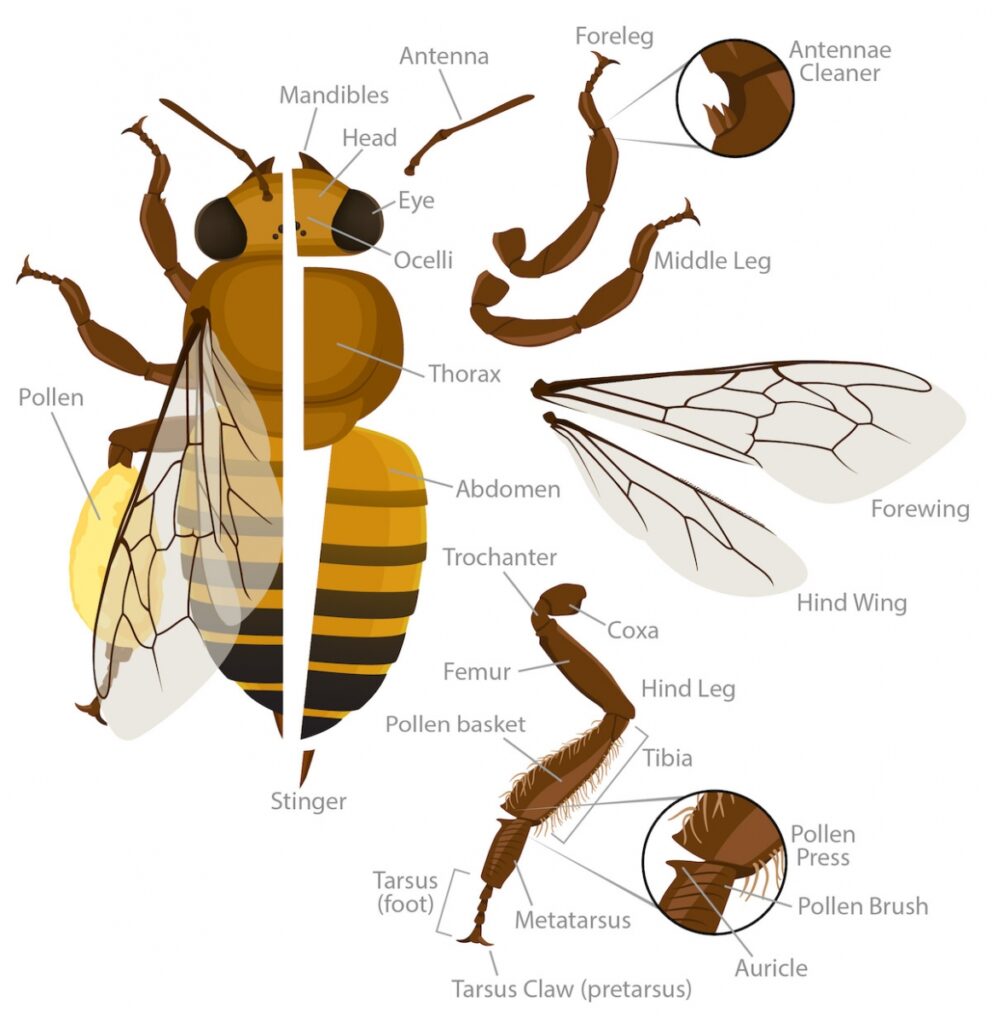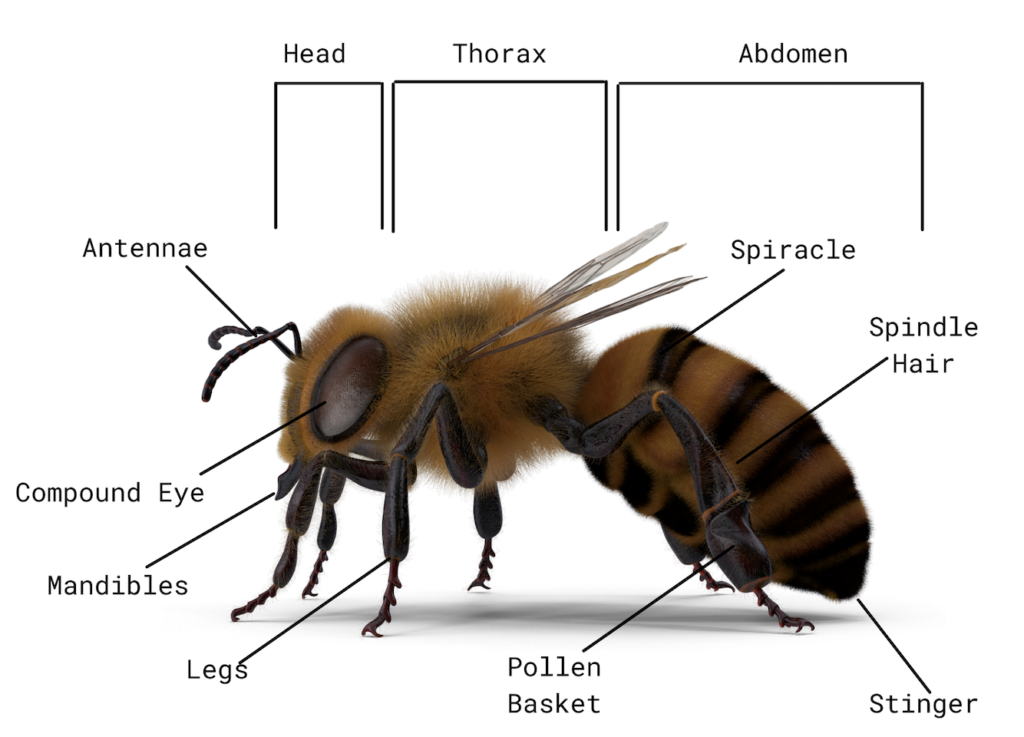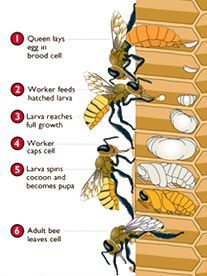
Have you ever wondered how bees organize themselves into such complex social structures? In the fascinating world of bees, their anatomy plays a crucial role in determining their roles and responsibilities within the hive. From the specialized bodies of worker bees to the reproductive functions of the queen, each member has a unique set of anatomical features that contributes to the smooth functioning of the colony. Join us as we embark on a journey into the secrets of the hive, exploring the intricacies of bee anatomy and its profound impact on their social structures.
Hive Structure and Function
Components of a Beehive
A beehive is a highly organized and intricate structure that serves as the home for a bee colony. It consists of various components that work together to ensure the survival and productivity of the colony. The main components of a beehive include the brood chamber, honey supers, frames, and entrances. The brood chamber is where the queen lays her eggs and the worker bees care for the developing larvae. Honey supers are additional boxes that are added to the hive to store excess honey. Frames are wooden or plastic frames that hold the wax (comb) where the bees build their cells for brood rearing and honey storage. Entrances provide the bees with access in and out of the hive.
Division of Labor in the Hive
Within a bee colony, there is a clear division of labor among its members. This division of labor is crucial for the smooth functioning of the hive and ensuring its survival. The three main roles within the hive are the queen bee, worker bees, and drone bees. Each of these roles has specific tasks and responsibilities that contribute to the overall success of the colony. The queen bee’s primary role is to lay eggs and ensure the reproduction of the colony. Worker bees, which make up the majority of the colony, are responsible for tasks such as foraging, nursing the brood, cleaning the hive, and producing wax, among others. Drone bees, on the other hand, are responsible for mating with virgin queens and do not perform any other tasks within the hive.
Communication within the Hive
Effective communication is crucial for the coordination and organization of a bee colony. Bees communicate with each other using various mechanisms, including pheromones and dance language. Pheromones are chemical signals released by the bees to convey information about the colony’s status, such as the presence of a queen or the need for food. These pheromones help maintain social order and ensure efficient functioning within the hive. Additionally, bees communicate through dance language. For example, honeybees perform a “waggle dance” to communicate the location of food sources to other workers. This intricate dance conveys information about the distance, direction, and quality of food, enabling efficient foraging by the worker bees.
The Importance of Anatomy in Bee Social Structures
Specialized Body Structures
The anatomy of a bee is highly specialized to fulfill the specific roles and functions within the hive. One of the most prominent specialized body structures of a bee is its exoskeleton. The exoskeleton provides the bee with a rigid outer shell that offers protection and support. This structure also serves as an attachment point for muscles, allowing the bee to move and carry out various tasks within the hive. Another important specialized body structure of a bee is its antennae. The antennae are sensory organs that help the bee perceive its environment, detect pheromones, and communicate with other bees. Additionally, bees have specialized mouthparts that are adapted for their unique feeding habits, allowing them to collect nectar and pollen.
Morphological Adaptations
Bees exhibit various morphological adaptations that are specific to their caste and role within the colony. One notable adaptation is the difference in body size between the different castes. Queen bees are larger in size compared to worker bees and drones. This difference in body size is essential for the queen’s reproductive role and the worker’s efficient execution of their assigned tasks. Furthermore, distinct morphologies can be observed within the different castes. For example, the queen bee has a longer abdomen and a pointed tip, enabling her to lay eggs in the cells of the brood comb. Worker bees, on the other hand, have specialized pollen baskets on their hind legs, allowing them to collect and transport pollen back to the hive.
Physiological Adaptations
In addition to specialized body structures, bees also possess various physiological adaptations that contribute to their role within the hive. One such adaptation is the reproductive system of the queen bee. The queen has a highly developed reproductive system that enables her to lay a large number of eggs, ensuring the continuous growth and survival of the colony. Another important physiological adaptation is seen in the digestive system of the worker bees. They have specialized enzymes and microorganisms within their digestive tract that help them break down and process nectar and pollen into honey and bee bread, which are essential food sources for the colony. Bees also have a well-developed nervous system that allows them to process complex sensory information and coordinate their movements and behaviors within the hive.

This image is property of askabiologist.asu.edu.
Specialized Body Structures
Exoskeleton
The exoskeleton is a defining feature of bees and plays a crucial role in their survival and functioning within the hive. It serves as a protective outer shell, shielding the bee from external threats such as predators and environmental factors. Additionally, the exoskeleton provides structural support, enabling the bee to carry out its tasks within the hive, including building and maintaining the honeycomb, caring for the brood, and foraging for food. The exoskeleton also acts as an attachment point for the bee’s muscles, allowing it to move and perform various actions necessary for its role within the colony.
Antennae
The antennae of a bee are highly sensitive sensory organs that serve multiple functions. They play a crucial role in the bee’s communication and navigation within the hive. Bees use their antennae to detect and interpret pheromones released by other bees, which convey important information about the colony’s status. The antennae also help bees navigate through the hive, allowing them to locate specific areas, such as the brood chamber or food sources. Additionally, the antennae are involved in touch and vibration perception, enabling bees to sense their immediate surroundings and interact with other bees.
Mouthparts
bees have specialized mouthparts that are adapted to facilitate their unique feeding habits. The mouthparts consist of various structures, including the proboscis, mandibles, and maxillae. The proboscis is a long, tube-like structure that allows bees to suck up nectar from flowers. It can also be used to siphon up water or gather floral oils. The mandibles are strong, jaws-like structures that help bees manipulate and process materials within the hive, such as wax and resin for honeycomb construction. The maxillae are equipped with sensory structures that aid in taste perception, allowing bees to assess the quality of nectar and pollen.
Morphological Adaptations
Different Body Sizes
One of the key morphological adaptations observed in bees is the difference in body size between the different castes. Queen bees are significantly larger in size compared to worker bees and drones. This difference in body size is crucial for the queen’s reproductive role within the colony. The larger body size allows the queen to carry a greater number of eggs and have a higher reproductive capacity. In contrast, worker bees are smaller in size, which allows them to perform their assigned tasks efficiently, such as foraging, nursing the brood, and grooming. Drones, the male bees, are also larger than the workers and have specialized adaptations for mating with virgin queens.
Distinct Morphologies in Castes
In addition to differences in body size, bees also exhibit distinct morphologies within their respective castes. For example, queen bees have a longer abdomen compared to worker bees and drones. The elongated abdomen allows the queen to lay eggs deep within the cells of the brood comb. This specialized morphology is critical for ensuring optimal egg placement and the successful development of the brood. Worker bees, on the other hand, have pollen baskets on their hind legs. These baskets are specialized structures that allow the workers to collect and transport pollen back to the hive for food storage. Such distinct morphologies within the castes enable bees to perform their specific roles effectively.

This image is property of hbrc.ca.
Physiological Adaptations
Reproductive System
The reproductive system of bees plays a vital role in the survival and continuation of the colony. Queen bees have a highly developed reproductive system that enables them to lay a large number of eggs. They possess specialized reproductive organs, including ovaries and spermatheca, which allow them to store and fertilize sperm from mating flights. With the stored sperm, the queen can lay fertilized eggs that will develop into worker bees, or unfertilized eggs that will become drones. The reproductive system of the queen bee is an integral part of the overall reproductive success of the colony.
Digestive System
Bees possess a unique digestive system that facilitates the processing of their food sources, such as nectar and pollen. In the honeybee digestive system, there are specialized enzymes and microorganisms that aid in the breakdown and fermentation of nectar into honey. Worker bees collect nectar, which is a sugary solution produced by flowers, and bring it back to the hive. Once inside the hive, worker bees deposit the nectar into cells, where it undergoes enzymatic transformations and moisture reduction through fanning by the bees’ wings. This process results in the formation of honey, which serves as an essential energy source for the colony. The digestive system of worker bees also allows them to process pollen into bee bread, a protein-rich food source for the developing brood.
Nervous System
The nervous system of bees is intricately structured to enable efficient communication, coordination, and response to external stimuli. Bees possess a well-developed central nervous system, with a brain that receives sensory input from various receptors located throughout the body. The brain processes this information and generates appropriate motor responses, allowing the bees to carry out complex behaviors and tasks within the hive. The sensory receptors, including the ones located on the antennae, allow bees to perceive and interpret signals from the environment, such as pheromones, vibrations, and temperature changes. This sensory input is crucial for the bees’ navigation, communication, and overall survival within their social structure.
Division of Labor in Bee Societies
Queen Bee
The queen bee is the central figure in a bee colony and is responsible for the reproductive success of the colony. Her primary role is to lay eggs, ensuring the continuous growth and expansion of the colony. The queen bee possesses specialized reproductive organs that allow her to lay a large number of eggs. She can lay both fertilized eggs, which develop into worker bees, and unfertilized eggs, which become drones. The queen bee also produces pheromones that maintain social cohesion within the colony. These pheromones influence the behavior and development of other bees and play a crucial role in the division of labor and task allocation.
Worker Bees
Worker bees are the backbone of the bee colony. They perform a wide range of tasks and are responsible for the day-to-day operations within the hive. Some of their key responsibilities include foraging for food (nectar and pollen), nursing the brood, cleaning and maintaining the hive, producing wax for comb construction, and defending the colony against intruders. Worker bees exhibit a high degree of specialization and flexibility, being able to switch between different tasks depending on the colony’s needs. The division of labor among worker bees is influenced by age, experience, and pheromonal cues from the queen.
Drone Bees
Drones are the male bees within a colony. Their primary purpose is to mate with virgin queens from other colonies to ensure genetic diversity and the continuation of the species. Unlike worker bees, drones do not perform any tasks within the hive, such as foraging or nursing. They have specialized adaptations for mating, including larger bodies, larger eyes, and reproductive organs. However, drones have a limited lifespan and are eventually expelled from the hive during periods of resource scarcity or as winter approaches.

This image is property of i.pinimg.com.
Communication within the Hive
Pheromones
Pheromones play a vital role in communication within the hive. Bees produce and release various pheromones that transmit important information to other members of the colony. The queen bee releases pheromones that indicate her presence and reproductive status. These pheromones help maintain social order and cohesion within the colony. Additionally, worker bees produce pheromones that convey information about the colony’s health, food availability, and the presence of potential threats. Pheromones also influence the development and behavior of other bees, such as initiating the worker bee’s transition from brood care to foraging.
Dance Language
Dance language is a fascinating form of communication used by honeybees to convey information about the location and quality of food sources. When a honeybee discovers a profitable food source, it returns to the hive and performs a unique dance known as the waggle dance. The waggle dance involves a series of movements, including waggling and circular motions, that provide directional information to other worker bees. By observing the dance, worker bees can determine the distance and direction of the food source and adjust their foraging behavior accordingly. Dance language facilitates efficient resource allocation and enhances the overall productivity of the colony.
Hierarchy and Organization
Queen Supremacy
In a bee colony, the queen holds a position of utmost importance, known as queen supremacy. The queen is the only fertile female in the colony and possesses a higher hierarchical status compared to the worker bees and drones. Her superiority is maintained through the release of pheromones that inhibit the development of worker bees’ reproductive organs and influence their behavior. The pheromones released by the queen also prevent the emergence of new queens within the colony, ensuring her monopoly on reproduction.
Social Hierarchy
Besides the queen supremacy, worker bees within the colony also exhibit a social hierarchy. The division of labor and task allocation among workers is influenced by factors such as age and experience. Older worker bees typically perform tasks that require more experience and physical strength, such as foraging and hive defense. Younger worker bees are involved in tasks such as nursing the brood and building comb. This social hierarchy facilitates efficient task execution and allows the colony to adapt and respond effectively to changing environmental conditions.
Task Allocation
Task allocation within the bee colony is based on a precise system that ensures the smooth functioning and productivity of the hive. The allocation of tasks is influenced by a combination of factors, including age, experience, and pheromonal signals from the queen and other worker bees. Young worker bees typically start by performing tasks within the hive, such as nursing the brood and building comb. As they mature, they transition to tasks outside the hive, including foraging for nectar and pollen. This dynamic task allocation allows for the effective utilization of the colony’s resources and optimizes its overall efficiency.
This image is property of lh4.googleusercontent.com.
Environmental Adaptations
Nest Architecture
The architecture of a bee’s nest is a remarkable example of environmental adaptation. Bees construct their nests in various locations, such as tree hollows or man-made structures like beehives. The nest architecture serves multiple purposes, including protection, storage, and organization. The hexagonal shape of the honeycomb cells maximizes storage space while requiring the least amount of materials. The arrangement of the cells allows for efficient communication, movement, and thermoregulation within the hive. The nest structure also provides insulation, helping to regulate the internal temperature and maintain the ideal conditions for brood rearing and honey storage.
Climate Control
Bees have developed effective mechanisms to control the climate within their hives, allowing them to maintain optimal conditions for the survival of the colony. They have the ability to regulate temperature, humidity, and ventilation within the hive. Worker bees engage in various behaviors, such as fanning their wings, clustering, or removing excess moisture, to regulate the temperature and humidity levels. During colder periods, bees huddle together, generating heat through muscular activity to maintain the temperature within the hive. This climate control is essential for the development of the brood, the storage of food, and the overall well-being of the colony.
Impact of Anatomy on Bee Social Structures
Survival and Reproduction
The anatomy of bees plays a crucial role in their survival and reproductive success within the social structure of the hive. The specialized body structures, such as the exoskeleton, antennae, and mouthparts, allow bees to perform essential tasks, including building and maintaining the hive, collecting food, and communicating with other members of the colony. Morphological adaptations, such as the size and shape differences between castes, enable bees to fulfill their specific roles and contribute to the overall functioning of the colony. Physiological adaptations, such as the reproductive and digestive systems, ensure the continuous growth and survival of the colony. Without these anatomical adaptations, bees would be unable to thrive and maintain their complex social structures.
Efficiency and Productivity
The anatomy of bees directly influences their efficiency and productivity within the hive. Specialized body structures, such as the exoskeleton and mouthparts, allow bees to carry out tasks with precision and efficiency. The exoskeleton provides support and protection, enabling bees to perform physically demanding activities. The mouthparts are specialized for the collection and processing of nectar and pollen, allowing bees to maximize their foraging efforts. Morphological adaptations, such as body size differences and distinct morphologies within castes, enhance the bees’ ability to perform specific tasks effectively. Physiological adaptations, such as the digestive system and nervous system, enable bees to efficiently process and utilize food resources and respond to environmental stimuli. The interplay between the anatomy and social structures of bees results in highly efficient and productive colonies.

This image is property of scientificbeekeeping.com.